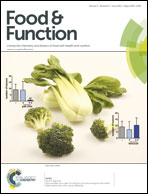Reactivity of food phenols with iron and copper ions: binding, dioxygen activation and oxidation mechanisms
Abstract
In this work, the affinity of common dietary phenols (gallic acid, caffeic acid, catechin, and rutin) for iron and copper ions was quantitatively investigated in neutral phosphate buffer as well as the reactivity of the complexes toward dioxygen. Contrasting behaviors were observed: because of the competing phosphate ions, FeIII binding is much slower than FeII binding, which is rapidly followed by autoxidation of FeII into FeIII. With both ions, O2 consumption and H2O2 production are modest and the phenolic ligands are only slowly oxidized. By contrast, metal–phenol binding is fast with both CuI and CuII. With CuI, O2 consumption and H2O2 production are very significant and the phenolic ligands are rapidly oxidized into a complex mixture of oligomers. The corresponding mechanism with CuII is hampered by the preliminary rate-determining step of CuII reduction by the phenols. The consequences of these findings for the stability and antioxidant activity of plant phenols are discussed.


 Please wait while we load your content...
Please wait while we load your content...